The United States is grappling with an unprecedented homelessness crisis, with a record 18% increase in homelessness reported over the past year, according to the U.S. Department of Housing and Urban Development (HUD). While the issue is multifaceted, the lack of affordable housing has emerged as the primary driver, exacerbated by economic challenges, systemic inequalities, and the lingering impact of the COVID-19 pandemic.
Affordable Housing at the Core of the Crisis
The affordable housing shortage is a nationwide problem that directly affects the homelessness epidemic. Stagnating wages for middle- and lower-income households, coupled with soaring housing costs, have left many Americans unable to secure stable housing. This crisis has pushed homelessness services to their breaking point, according to HUD.
Research by the National Low Income Housing Coalition highlights that for every 100 extremely low-income renter households, only 37 affordable rental homes are available. The lack of housing affordability has forced families to choose between basic needs like food and healthcare or paying rent, often resulting in homelessness.
Vulnerable Groups Hit Hardest
Certain demographic groups face disproportionately higher rates of homelessness, revealing systemic inequities within the housing market. Black Americans, who represent just 12% of the total U.S. population, accounted for 32% of the homeless population. This disparity underscores the ongoing impact of systemic racism and economic inequality.
Children are another vulnerable group experiencing significant hardship. HUD’s data indicates a 33% rise in homelessness among children under 18 between 2023 and 2024, with 150,000 children affected. These statistics highlight the urgency of addressing housing instability as part of broader efforts to protect vulnerable populations.
The Role of Economic Pressures and Policy Gaps
Beyond housing affordability, other economic pressures are contributing to rising homelessness. Inflation has driven up the cost of basic goods and services, while wage growth has lagged behind. The expiration of COVID-era housing protections, such as eviction moratoriums and rental assistance programs, has further exposed families to the risk of homelessness.
HUD also points to additional stressors, including natural disasters displacing residents, increased immigration without adequate housing support, and public health challenges. These overlapping crises compound the difficulty of creating effective solutions to homelessness.
Diverging Approaches to Addressing the Problem
Federal and state governments have adopted different strategies to combat homelessness, often reflecting ideological divides. While some states focus on temporary shelter programs, others prioritize long-term affordable housing initiatives. However, experts emphasize that systemic changes—such as expanding affordable housing stock, increasing rental assistance, and addressing wage stagnation—are essential for meaningful progress.
A Call for Action
The 18% surge in homelessness is a stark reminder of the urgent need to address America’s affordable housing crisis. Policymakers must prioritize systemic reforms to ensure access to affordable housing, while addressing broader economic inequalities and racial disparities. As the crisis deepens, a unified, multi-pronged approach is essential to mitigate the devastating human and societal impacts of homelessness.
(Source:www.cbsnews.com)
Affordable Housing at the Core of the Crisis
The affordable housing shortage is a nationwide problem that directly affects the homelessness epidemic. Stagnating wages for middle- and lower-income households, coupled with soaring housing costs, have left many Americans unable to secure stable housing. This crisis has pushed homelessness services to their breaking point, according to HUD.
Research by the National Low Income Housing Coalition highlights that for every 100 extremely low-income renter households, only 37 affordable rental homes are available. The lack of housing affordability has forced families to choose between basic needs like food and healthcare or paying rent, often resulting in homelessness.
Vulnerable Groups Hit Hardest
Certain demographic groups face disproportionately higher rates of homelessness, revealing systemic inequities within the housing market. Black Americans, who represent just 12% of the total U.S. population, accounted for 32% of the homeless population. This disparity underscores the ongoing impact of systemic racism and economic inequality.
Children are another vulnerable group experiencing significant hardship. HUD’s data indicates a 33% rise in homelessness among children under 18 between 2023 and 2024, with 150,000 children affected. These statistics highlight the urgency of addressing housing instability as part of broader efforts to protect vulnerable populations.
The Role of Economic Pressures and Policy Gaps
Beyond housing affordability, other economic pressures are contributing to rising homelessness. Inflation has driven up the cost of basic goods and services, while wage growth has lagged behind. The expiration of COVID-era housing protections, such as eviction moratoriums and rental assistance programs, has further exposed families to the risk of homelessness.
HUD also points to additional stressors, including natural disasters displacing residents, increased immigration without adequate housing support, and public health challenges. These overlapping crises compound the difficulty of creating effective solutions to homelessness.
Diverging Approaches to Addressing the Problem
Federal and state governments have adopted different strategies to combat homelessness, often reflecting ideological divides. While some states focus on temporary shelter programs, others prioritize long-term affordable housing initiatives. However, experts emphasize that systemic changes—such as expanding affordable housing stock, increasing rental assistance, and addressing wage stagnation—are essential for meaningful progress.
A Call for Action
The 18% surge in homelessness is a stark reminder of the urgent need to address America’s affordable housing crisis. Policymakers must prioritize systemic reforms to ensure access to affordable housing, while addressing broader economic inequalities and racial disparities. As the crisis deepens, a unified, multi-pronged approach is essential to mitigate the devastating human and societal impacts of homelessness.
(Source:www.cbsnews.com)






